|
1A
|
Fore
tarsi four -
segmented (fig.a); laminar projection present on the proximal fore tarsal
segment (fig. a); clypeal sutures meet before the toruli (fig. b);
usually with a long thin ovipositor (ca. as long as gaster) (fig. c),
but this can be short; hypopygium often extending well beyond end of the metasoma
(fig. c), but can also not protrude (Brunei, Indonesia, Malaysia,
Philippines, China) ...Diaziella
Fourteen
described species.
Key: van Noort, Peng &
Rasplus (2006). Thirty new
species currently being described (van Noort & Rasplus in prep.).
|
|
1B
|
Fore
tarsi five -
segmented; laminar projection absent (a); if the clypeal sutures are present then
they are separate (b), or if they meet before the toruli then the clypeal margin is
narrow (less than a third of the head width); ovipositor short; hypopygium never
extending beyond end of metasoma (figs. c
& d)
...2
|
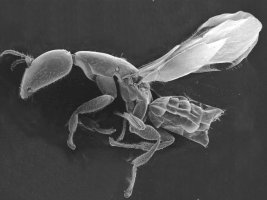
d |
|
|
|
2A
|
No antennal
scrobe (fig. a); clypeal sutures not
defined (fig. b); medial carina
present between the toruli (fig. c); ovipositor short, usually not discernable
(fig. d) (Papua New
Guinea) ...Robertsia
Four
species in Papua New Guinea.
Key: van Noort
& Rasplus 2005
|
|
2B
|
Antennal scrobe present (fig a); clypeal sutures present (fig b); no
medial carina between the toruli (fig c); ovipositor distinctly protruding ((fig.
d) Afrotropical
region)
...3
|
|
3A
|
Fore tibial spur expanded, plate-like, with many small teeth (fig.
a);
propleura excavated (fig. b); first funicle segment expanded antiaxially
relative to other segments (fig. c); two labial and four maxillary palp segments
...Sycoecus
Afrotropical. Ten
described species. Probably gall-makers. Restricted to Ficus
species in subsection Cyathistipulae. Key to
species: van Noort (1993b).
|
|
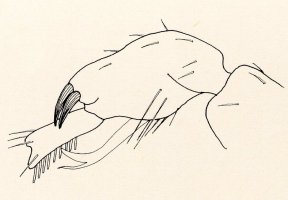
a |
b |

c
|
|
3B
|
Fore tibial spur
normal (fig. a);
propleura not excavated (fig. b); first funicle segment not expanded (fig. c); two or three
maxillary palp segments ...4
|
|
4A
|
Eighth urotergite spiracular peritremata expanded (fig.
a); marginal vein
thin (more than 8X longer than wide); 1 labial, 2 maxillary palp segments;
ventral tentorial pits usually distinctly and widely separated (fig. b), or if
in close apposition, then the toruli are situated more than their length below
an imaginary line joining the base of the eyes and the head is elongate
(more than 1.5X longer than wide) (fig. c) ...Crossogaster
Afrotropical.
Sixteen described species, few undescribed, the host association is less tight
than those of Seres and Sycoecus.
Most species develop in figs of the subsection Platyphyllae
and Chlamydodorae. Very probably
gall makers. Key to species: van Noort (1994a).
|
|
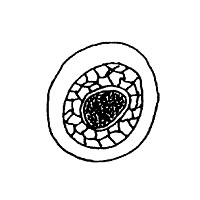
a |
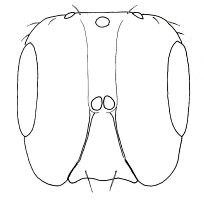
b |
|
|
4B
|
Eighth urotergite spiracular
peritremata not expanded (fig. a); marginal vein thickened (less than 8X longer
than wide); 2 labial and 3 maxillary palp segments; ventral tentorial pits
indistinguishable as separate, or in very close apposition; toruli usually
situated between or in line with the base of the eyes (fig. b), if below
then a plate of teeth is present on the fore tibia and the head is less
than 1.25X longer than wide ...Seres
Seres
contains 26 described species, all Afrotropical. They are associated with Ficus
of the section Galoglychia, and of
the subsections Platyphyllae and Chlamydodorae, Caulocarpae.
Key to species: van Noort (1993a, 1994c) as Philocaenus and Seres
prior to synonymization of Philocaenus with Seres (Cruaud
et al 2013).
|
|
1A
|
Apterous
(figs. a, b & c) (Australasian region: Papua New Guinea) ...Robertsia
|
|
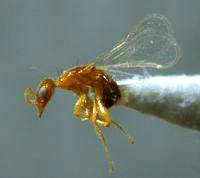
a |
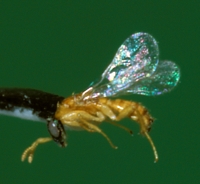
b
|
|
|
1B
|
Fully winged
(figs. a & b) (Oriental and Afrotropical regions) ...2
|
|
2A
|
Fore tarsi four - segmented (Oriental region: Malaysia, Indonesia,
China) ...Diaziella
|
|
2B
|
Fore
tarsi five - segmented
(Afrotropical region) ...3
|
|

a |
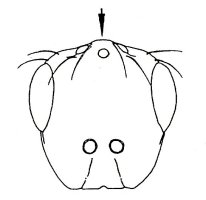
b |
|
|
3A
|
Two apical mandibular teeth and a single ventral tooth, mandible short
and squat (fig. a), head always yellowish-brown; vertex produced medially between
the lateral ocelli (fig. b) ...Sycoecus
|
|
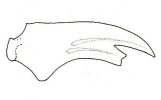
a |
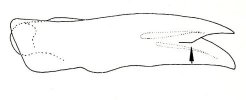
b |
|
3B
|
Mandible more elongate with two apical teeth and no ventral tooth (fig. a), or
if the ventral tooth is present (fig. b) then the head is metallic green; vertex
evenly rounded ...4
|
|
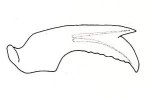
a |

b |
|
|
4A
|
Outer mandibular apical tooth usually distinctly shorter than the inner
(fig. a), or if only marginally shorter then a small ventral tooth is present
(fig. b) and the toruli are separated by at least three-quarters of a torulus
width ...Crossogaster
|
|

a |
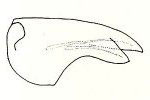
b |
|
|
4B
|
Outer mandibular apical
tooth usually distinctly longer than the inner (fig. a), or if only marginally
longer then no ventral tooth is present (fig. b) and the toruli are separated
by less than a quarter of a torulus width ...Seres
|
|